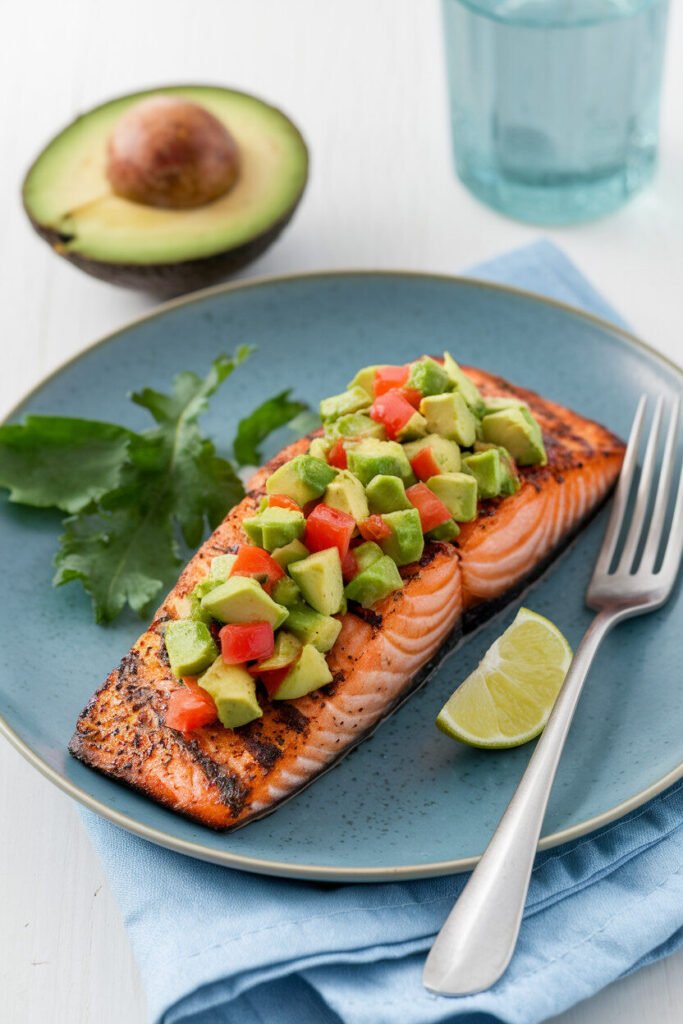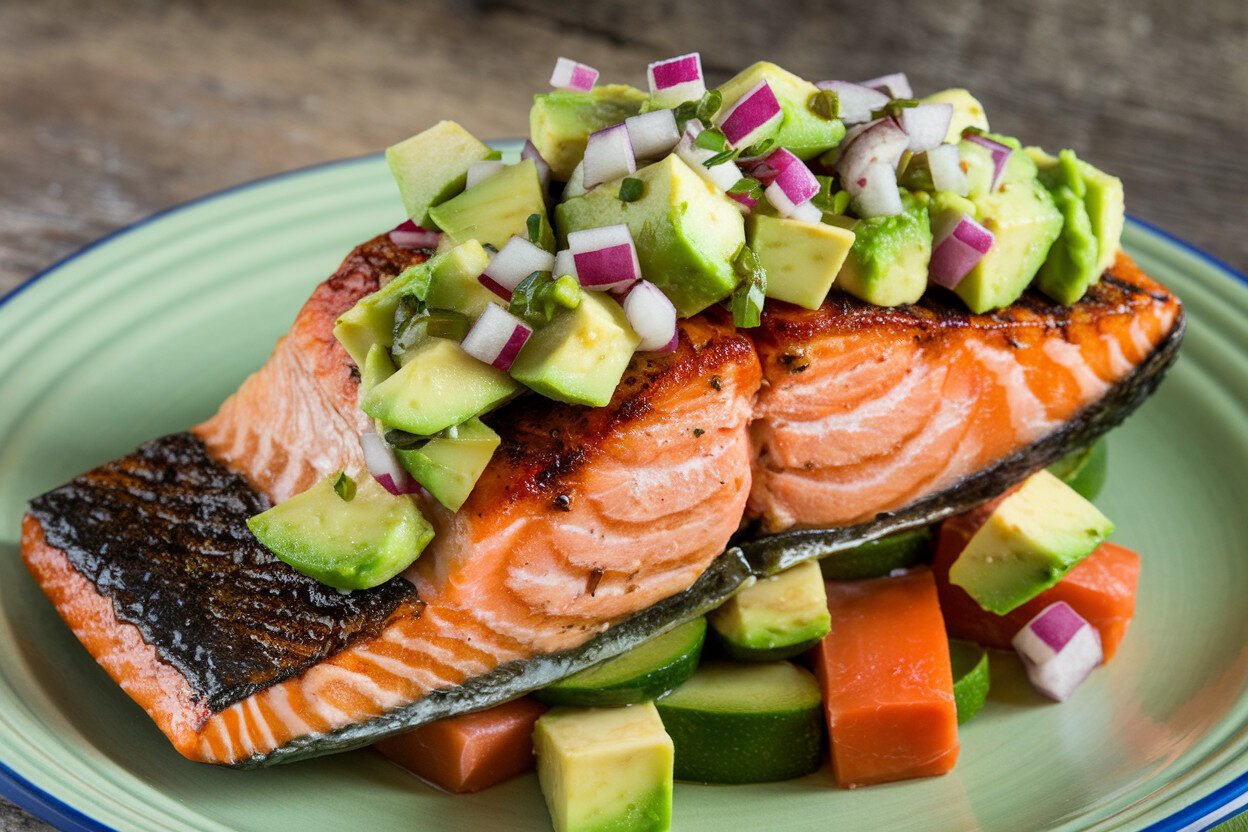Let’s be real – most “healthy” recipes taste like punishment. But this grilled salmon with avocado salsa? It’s the exception that proves the rule. After developing recipes professionally for a decade, I can tell you this combination works because it follows fundamental flavor principles rather than diet trends. The rich, fatty salmon stands up beautifully to the bright, acidic salsa, creating a balance that feels indulgent while being genuinely good for you.
I’ve served this to skeptical friends who claimed they didn’t like fish, and watched them clean their plates. The magic isn’t in complicated techniques – it’s in understanding how to maximize flavor with minimal effort. You’re getting restaurant-quality results with maybe 20 minutes of active work.
Why This Grilled Salmon with Avocado Salsa Actually Tastes Good
The Flavor Science Behind Perfectly Paired Textures
What makes this combination so compelling is the contrast – and I’m not just talking about taste. The crispy, slightly charred salmon skin against the creamy avocado. The firm, flaky fish against the chunkier salsa. The warm protein against the cool topping. These textural differences make each bite interesting in a way that monotextural “healthy” meals rarely achieve.
From a culinary science perspective, the fats in salmon (those beneficial omega-3s) carry flavor beautifully, while the avocado’s creaminess comes from its unique combination of fats and fibers. When you add the acidity from lime juice in the salsa, it cuts through the richness in a way that makes everything taste cleaner, brighter. It’s the same principle chefs use when pairing fatty fish with citrus – think ceviche, but with heat applied.
Why This Recipe Beats Every Other Salmon Dish You’ve Tried
Most salmon recipes fail for one of two reasons: they either overcook the fish into dry sadness, or they drown it in heavy sauces that mask its natural flavor. This method avoids both pitfalls by keeping things simple. The high heat of the grill creates that beautiful crust while keeping the interior moist, and the salsa adds freshness without heaviness.
I’ve tested countless salmon preparations – pan-seared, baked, poached, you name it – and grilling gives you the best texture contrast. The direct heat renders the fat in the skin, making it shatteringly crisp, while the relatively short cooking time preserves the fish’s moisture. Plus, that slight smokiness from the grill? It adds complexity without needing a dozen ingredients.
Your Simple Ingredients for Maximum Flavor Impact
Selecting the Right Salmon Cut for Grilling
Not all salmon is created equal when it comes to grilling. Through extensive testing, I’ve found that center-cut fillets with the skin on work best. They’re typically 1 to 1.5 inches thick – substantial enough to stand up to the grill without overcooking, but not so thick that the skin burns before the interior cooks.
I prefer wild-caught king or sockeye salmon when it’s available – the flavor is more complex, and the texture is firmer, which helps it hold together on the grill. That said, high-quality farmed Atlantic salmon works beautifully too – just look for fillets with good marbling (those white lines of fat) and vibrant color. Avoid thin tail pieces – they cook too quickly and dry out.
The Complete Ingredients List for Salmon and Salsa
For the salmon:
- 4 (6-ounce) salmon fillets, skin on, about 1-inch thick
- 2 tablespoons olive oil
- 1 teaspoon kosher salt (I prefer Diamond Crystal – it’s less salty by volume than Morton’s)
- ½ teaspoon black pepper
- 1 teaspoon smoked paprika (this adds depth without making it taste “smoked”)
- ½ teaspoon garlic powder
For the avocado salsa:
- 2 ripe but firm avocados, diced
- 1 cup cherry tomatoes, quartered
- ¼ cup red onion, finely diced
- 1 jalapeño, seeded and minced (optional, but recommended)
- ¼ cup cilantro, chopped
- 2 tablespoons fresh lime juice (about 1 lime)
- 1 tablespoon olive oil
- ½ teaspoon salt

Avocado Selection Tips That Actually Matter
Choosing avocados for salsa is different than choosing them for guacamole. You want them ripe but still firm enough to hold their shape when diced and mixed. The squeeze test works, but I’ve found the stem method more reliable – pop off the small stem at the top; if it’s green underneath, you’re good. If it’s brown, it’s overripe.
Here’s a pro tip I learned from a produce manager: if your avocados are rock hard, store them in a paper bag with a banana overnight. The ethylene gas the banana emits will speed up ripening dramatically. For this recipe, you want avocados that yield to gentle pressure but don’t feel mushy – that perfect sweet spot where they’re creamy but still structural.
The Foolproof Method for Perfect Grilled Salmon Every Time
Preparing Your Salmon for the Grill
The key to getting that crispy skin? Starting with dry fish. I pat my salmon fillets thoroughly with paper towels, getting both the skin side and the flesh side completely dry. Then I brush them lightly with olive oil – just enough to coat, not so much that it drips and causes flare-ups.
Seasoning is crucial here – I mix the salt, pepper, smoked paprika, and garlic powder together first, then sprinkle it evenly over both sides. Don’t be shy with the seasoning – some will fall off during grilling, and salmon can handle bold flavors. Let it sit at room temperature for about 15 minutes while you prep the salsa and heat the grill. This brief rest helps it cook more evenly.
Mastering Grill Temperature and Cook Time
This is where most people go wrong – they grill salmon over flames that are either too hot or too cool. You want medium-high heat, around 400-450°F. If you’re using a gas grill, that’s usually medium-high on the dial. For charcoal, you should be able to hold your hand about 6 inches above the grates for 3-4 seconds before pulling away.
Place the salmon skin-side up first. Wait, what? Yes – you start with the flesh side down. This gives you those beautiful grill marks where they’re most visible, and it allows the skin to get extra crispy when you flip it. Cook for 4-5 minutes on the first side, then flip and cook another 3-4 minutes skin-side down. The salmon is done when it flakes easily but still looks slightly translucent in the very center – it’ll continue cooking from residual heat.
Assembling Your Avocado Salsa Like a Pro
While the salmon is resting (crucial step – don’t skip it!), I make the salsa. The order of operations matters here – I start with the diced red onion and jalapeño in the bowl with the lime juice and salt. Letting these sit for 5-10 minutes mellows their sharpness. Then I add the tomatoes and cilantro, and finally the avocado, gently folding to combine.
The goal is to keep the avocado pieces intact, so I use a rubber spatula and fold from the bottom up rather than stirring aggressively. Taste and adjust seasoning – you might need more lime juice or salt depending on your avocados. Spoon it generously over the rested salmon, and you’ve got a meal that looks and tastes far more impressive than the effort required.
Frequently Asked Questions
How do I know when my salmon is done cooking?
The finger test works surprisingly well – press the thickest part of the fillet gently; it should feel firm but still have some give, like the base of your thumb when you touch your thumb to your pinky. For a more precise method, I use an instant-read thermometer – 125-130°F for medium-rare, 135-140°F for medium. Remember, it’ll continue cooking after you take it off the grill, so pull it a few degrees before your target temperature.
Can I make this grilled salmon with avocado salsa ahead of time?
You can prep components ahead, but I don’t recommend assembling completely. The salmon is best served within 30 minutes of grilling, though it’s still decent cold. The avocado salsa should be made no more than an hour before serving, and even then, keep the lime juice on it – the acidity helps prevent browning. You can chop all the salsa ingredients ahead and combine them at the last minute.
What’s the best way to store and reheat leftovers?
Store salmon and salsa separately in airtight containers in the refrigerator. The salmon will keep for 2 days, the salsa for 1 day (avocados brown eventually, despite the lime juice). To reheat salmon, I use a 300°F oven for 10-12 minutes – microwaving makes it rubbery. The salsa is best cold, so just spoon it over the reheated salmon.
Can I use frozen salmon for this recipe?
Absolutely – just thaw it properly. The best method is in the refrigerator overnight. If you’re short on time, place the vacuum-sealed package in a bowl of cold water, changing the water every 30 minutes. Never thaw at room temperature or in warm water – you’ll end up with mushy texture. And pat it very dry before grilling – frozen fish releases more moisture.
What if I don’t have a grill?
A cast-iron skillet gets you surprisingly close to grill results. Heat it over medium-high heat until very hot, add a tablespoon of oil, and cook the salmon using the same timing – skin-side up first, then flip to crisp the skin. You won’t get grill marks, but you’ll get that beautiful crust. You could also use a grill pan if you have one.
How can I tell if an avocado is ripe enough?
The stem method I mentioned is reliable, but here’s another trick: gently press the top (where the stem was) and bottom – they should give slightly while the middle remains firm. If the whole thing feels soft, it’s overripe. Color can be misleading – Hass avocados turn dark when ripe, but other varieties stay green.
What sides pair well with grilled salmon and avocado salsa?
I love this with simple sides that don’t compete – cilantro lime rice, roasted asparagus, or a simple green salad. The Academy of Nutrition and Dietetics recommends filling half your plate with vegetables, so maybe add some steamed broccoli or a quick cucumber salad. The beauty of this dish is that it feels complete on its own, so sides can be minimal.
